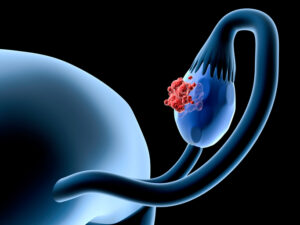There are currently three antibody drug conjugates (ADC) targeting B7-H4 being tested in clinical trials: AZD8205 (NCT05123482), SGN-B7-H4V (NCT05194072) and XMT-1660 (NCT05377996). You can use Clearity’s clinical trial finder to find more information about these trials.
As part of the annual meeting of the American Association for Cancer Research (AACR) in Orlando, FL, researchers from the Perelman School of Medicine at the University of Pennsylvania have not only identified a new target for drug-resistant ovarian cancer but also provided supporting evidence for a potential treatment approach.
According to a recent statistic published by the AACR, nearly 20,000 women will be diagnosed with ovarian cancer in 2023. Despite recent treatment advances, survival rates remain relatively low, revealing the need for novel targets and therapy options—especially for recurrent ovarian cancer.

Presenting at the 2023 AACR annual meeting, researchers from the University of Pennsylvania say they have now been able to verify the B7-H4 protein as a potentially high-impact target found in the majority of ovarian cancers at diagnosis. The protein remained overexpressed in cancer patients even after treatment with platinum chemotherapy or PARP inhibitors—the current standards of care for ovarian cancer.
“Unfortunately the majority of ovarian cancers recur and become resistant to standard platinum chemotherapy,” said Fiona Simpkins, MD, professor of obstetrics and gynecology at the University of Pennsylvania and senior author of the study. “Platinum-resistant ovarian cancer is the most challenging type of ovarian cancer to treat, and developing new therapies in this area is an urgent priority.”
To identify B7-H4 as a viable target, the team used matched samples from the Penn Ovarian Cancer Research Center Tumor BioTrust Collection and analyzed whether the protein was found in tumor tissue after treatment and where it was localized. According to the researchers, the protein was overexpressed in 92% of high-grade serous ovarian carcinoma tumors and consistently found on the outside of cells.
After verification, the team targeted B7-H4 in different cell lines as well as patient-derived xenograft (PDX) models using an antibody-drug conjugate (ADC)—a new type of immunotherapy drug that uses the specificity of antibody-binding to deliver a drug to its target. The ADC proved efficient in 61% of the PDX models, decreasing tumor size after just one dose.
“We saw excellent anti-tumor activity, sustained over a long period of time in models that are drug-resistant, which is uncommon,” said Sarah Gitto, PhD, presenter of the study at the annual AACR meeting. “We’ve been able to show that B7-H4 is a very robust and widespread target that can be used across multiple stages of patient care.”
The antibody-drug-conjugate targeting the B7-H4 protein in ovarian cancer is now being tested in a multisite Phase I clinical trial.
“We’re excited about the potential for antibody-drug conjugates to overcome drug resistance, and this work shows they merit further development in ovarian cancer,” Simpkins concluded in a press statement. “This type of progress is possible thanks to the patients who participate in research, including biospecimen banking programs that allow scientists to learn about how their disease changes over time.”
This article was published by Inside Precision Medicine.


